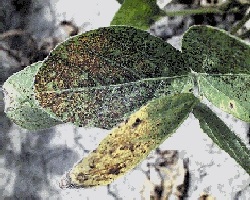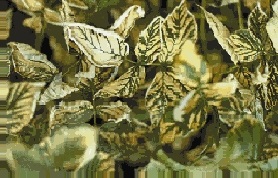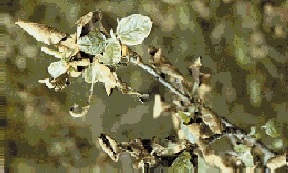Effects of air pollution on agricultural crops
Learn how to identify damage caused by various air pollutants on agricultural crops.
Introduction
Agricultural crops can be injured when exposed to high concentrations of various air pollutants. Injury ranges from visible markings on the foliage, to reduced growth and yield, to premature death of the plant. The development and severity of the injury depends not only on the concentration of the particular pollutant, but also on a number of other factors. These include the length of exposure to the pollutant, the plant species and its stage of development as well as the environmental factors conducive to a build-up of the pollutant and to the preconditioning of the plant, which make it either susceptible or resistant to injury.
Air pollution problems in Ontario
In Ontario, air pollutants injurious to vegetation can generally be classed as either local or widespread. Local pollutants are those emitted from a specific stationary source and result in a well-defined zone of vegetation injury or contamination. Most common among the local pollutants are sulfur dioxide, fluorides, ammonia and particulate matter. Widespread pollutants consist primarily of "oxidants". Ozone, the major component of oxidants, is produced in the atmosphere during a complex reaction involving nitrogen oxides and reactive hydrocarbons, components of automobile exhausts and fossil fuel combustion. As this process proceeds only in sunlight, it is called a photo-chemical reaction. The vegetation injury, which can result from oxidant build-up in the air, can occur over large rural areas covering hundreds of square kilometres.
Effects of air pollution on plants
Air pollution injury to plants can be evident in several ways. Injury to foliage may be visible in a short time and appear as necrotic lesions (dead tissue), or it can develop slowly as a yellowing or chlorosis of the leaf. There may be a reduction in growth of various portions of a plant. Plants may be killed outright, but they usually do not succumb until they have suffered recurrent injury.
Oxidants
Ozone is the main pollutant in the oxidant smog complex. Its effect on plants was first observed in the Los Angeles area in 1944. Since then, ozone injury to vegetation has been reported and documented in many areas throughout North America, including the southwestern and central regions of Ontario. Throughout the growing season, particularly July and August, ozone levels vary significantly. Periods of high ozone are associated with regional southerly air flows that are carried across the lower Great Lakes after passing over many urban and industrialised areas of the United States. Localized, domestic ozone levels also contribute to the already high background levels. Injury levels vary annually and white bean, which are particularly sensitive, are often used as an indicator of damage. Other sensitive species include cucumber, grape, green bean, lettuce, onion, potato, radish, rutabagas, spinach, sweet corn, tobacco and tomato. Resistant species include endive, pear and apricot.
Ozone symptoms (Figure 1) characteristically occur on the upper surface of affected leaves and appear as a flecking, bronzing or bleaching of the leaf tissues. Although yield reductions are usually with visible foliar injury, crop loss can also occur without any sign of pollutant stress. Conversely, some crops can sustain visible foliar injury without any adverse effect on yield.
Susceptibility to ozone injury is influenced by many environmental and plant growth factors. High relative humidity, optimum soil-nitrogen levels and water availability increase susceptibility. Injury development on broad leaves also is influenced by the stage of maturity. The youngest leaves are resistant. With expansion, they become successively susceptible at middle and basal portions. The leaves become resistant again at complete maturation.
Sulfur dioxide
Major sources of sulfur dioxide are coal-burning operations, especially those providing electric power and space heating. Sulfur dioxide emissions can also result from the burning of petroleum and the smelting of sulfur containing ores.
Sulfur dioxide enters the leaves mainly through the stomata (microscopic openings) and the resultant injury is classified as either acute or chronic. Acute injury (Figure 2) is caused by absorption of high concentrations of sulfur dioxide in a relatively short time. The symptoms appear as 2-sided (bifacial) lesions that usually occur between the veins and occasionally along the margins of the leaves. The colour of the necrotic area can vary from a light tan or near white to an orange-red or brown depending on the time of year, the plant species affected and weather conditions. Recently expanded leaves usually are the most sensitive to acute sulfur dioxide injury, the very youngest and oldest being somewhat more resistant.
Chronic injury is caused by long-term absorption of sulfur dioxide at sub-lethal concentrations. The symptoms appear as a yellowing or chlorosis of the leaf, and occasionally as a bronzing on the under surface of the leaves.
Different plant species and varieties and even individuals of the same species may vary considerably in their sensitivity to sulfur dioxide. These variations occur because of the differences in geographical location, climate, stage of growth and maturation. The following crop plants are generally considered susceptible to sulfur dioxide: alfalfa, barley, buckwheat, clover, oats, pumpkin, radish, rhubarb, spinach, squash, Swiss chard and tobacco. Resistant crop plants include asparagus, cabbage, celery, corn, onion and potato.
Fluoride
Fluorides are discharged into the atmosphere from the combustion of coal; the production of brick, tile, enamel frit, ceramics, and glass; the manufacture of aluminium and steel; and the production of hydrofluoric acid, phosphate chemicals and fertilizers.
Fluorides absorbed by leaves are conducted towards the margins of broad leaves (grapes) and to the tips of monocotyledonous leaves (gladiolus). Little injury takes place at the site of absorption, whereas the margins or the tips of the leaves build up injurious concentrations. The injury (Figure 3) starts as a gray or light-green water-soaked lesion, which turns tan to reddish-brown. With continued exposure the necrotic areas increase in size, spreading inward to the midrib on broad leaves and downward on monocotyledonous leaves.
Studies of susceptibility of plant species to fluorides show that apricot, barley (young), blueberry, peach (fruit), gladiolus, grape, plum, prune, sweet corn and tulip are most sensitive. Resistant plants include alfalfa, asparagus, bean (snap), cabbage, carrot, cauliflower, celery, cucumber, eggplant, pea, pear, pepper, potato, squash, tobacco and wheat.
Ammonia
Ammonia injury to vegetation has been observed frequently in Ontario in recent years following accidents involving the storage, transportation or application of anhydrous and aqua ammonia fertilizers. These episodes usually release large quantities of ammonia into the atmosphere for brief periods of time and cause severe injury to vegetation in the immediate vicinity.
Complete system expression on affected vegetation usually takes several days to develop, and appears as irregular, bleached, bifacial, necrotic lesions. Grasses often show reddish, interveinal necrotic streaking or dark upper surface discolouration. Flowers, fruit and woody tissues usually are not affected, and in the case of severe injury to fruit trees, recovery through the production of new leaves can occur (Figure 4). Sensitive species include apple, barley, beans, clover, radish, raspberry and soybean. Resistant species include alfalfa, beet, carrot, corn, cucumber, eggplant, onion, peach, rhubarb and tomato.
Particulate matter
Particulate matter such as cement dust, magnesium-lime dust and carbon soot deposited on vegetation can inhibit the normal respiration and photosynthesis mechanisms within the leaf. Cement dust may cause chlorosis and death of leaf tissue by the combination of a thick crust and alkaline toxicity produced in wet weather. The dust coating (Figure 5) also may affect the normal action of pesticides and other agricultural chemicals applied as sprays to foliage. In addition, accumulation of alkaline dusts in the soil can increase soil pH to levels adverse to crop growth.
Investigation of air-pollution injury to vegetation
The Ministry of the Environment, Conservation and Parks monitors air quality at 33 stations across the province. The sites are set in both urban and rural settings and monitor the 6 most common air pollutants: sulfur dioxide, ozone, nitrogen dioxide, total reduced sulfur compounds, carbon monoxide and suspended particles. The sites are monitored in real-time on an hourly basis. Pollutant concentrations are converted into an Air Quality Index (AQI) with a lower AQI translating into cleaner air. AQI values above 50 can cause crop injury.
Information on Ontario air quality
For an English recording of air quality readings and forecasts, dial
For general public inquiries about the Air Quality Index, call
For more information on air quality, visit the Ministry of the Environment, Conservation and Park's website or contact the Public Information Centre at




